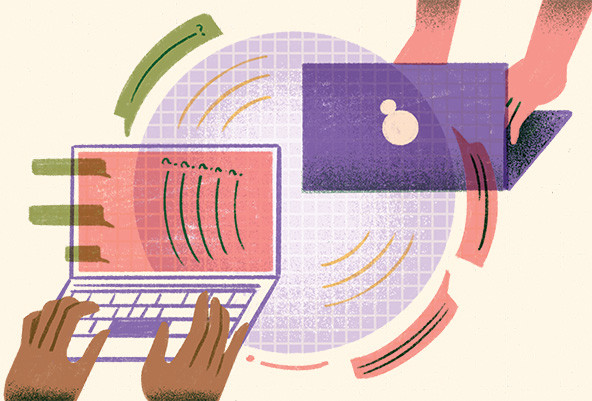 (Illustration by Vanessa Lovegrove)
(Illustration by Vanessa Lovegrove)
The digital revolution that began two decades ago enabled organizations to share information and communicate with large numbers of people over vast spaces quickly and inexpensively. However, this digital connection and the immediacy it afforded came with a huge cost: the erosion of boundaries between work and home life, resulting in the demand for the always-on and always-connected worker. We are encumbered by the endless, daily battle of email whack-a-mole. Statistically, American workers check their email on average 74 times a day.
Next Generation Nonprofits

Cloud technology provides the innovations necessary for nonprofits to more effectively serve their constituencies, increase donor and member engagement, and enhance stakeholder experience. This supplement shares insights into how your organization can use this technology to jump-start your success. Sponsored by AWS
A new chapter in digital technology is emerging that operates very differently from the previous generation of digital tech like email and social media that made life faster—but not necessarily better—for workers. It will free workers from the time-consuming, rote tasks that take up 30 percent of staff time. This newly freed time provides nonprofit workers the opportunity to pivot to building relationships, sharing stories, and solving big problems. In other words, workers will be able to spend much more time on meaningful work and less time on busywork.
In our new book, The Smart Nonprofit, we define this next generation of “smart tech” as the universe of technologies that includes artificial intelligence (AI) and its subsets and cousins, such as machine learning and natural language processes, that all rely on cloud computing. These technologies—rather than individuals—use Library of Congress-size data sets to find patterns and make decisions for people. Current commercial applications are being used by organizations to screen resumes, answer frequently asked and fact-based questions (e.g., “What time do you open?” and “Is my donation tax deductible?”), automatically update budgets, organize meetings, and research donor prospects.
The purpose of using the technology in organizations isn’t to do more, faster, but to free people from time-consuming tasks and create what we call a “dividend of time”—the surplus of time that is produced from having smart tech replacing basic, repetitive tasks. This new time can be allocated for tasks and activities that only people can do, such as building stronger relationships and solving problems. Or, this dividend of time could afford us the ability to pace ourselves and our labor for our personal benefit and for the benefit of the work we produce.
The articles in this series exemplify how next-generation nonprofits are employing cloud-powered smart tech to improve the quality of their work and their staff’s lives. For example, Share Our Strength, an organization dedicated to finding solutions to poverty, uses this tech to gain insights for fundraising. The nonprofit and renowned art museum the Barnes Foundation relies on it to make art education more accessible to all. And charity: water, a nonprofit dedicated to providing clean water to developing nations, uses smart tech to facilitate their processes in order to make clean drinking water more reliably available. A common factor uniting the nonprofit efforts enumerated in this supplement is that each has an organizational leadership that understands why, where, and when to use smart tech.
Cobotting
In addition to program delivery, smart tech applications are available for every department, from communications to accounting to service delivery. Efficacious use of this technology requires a deep understanding of what it is and does, in addition to careful, strategic thought on how to incorporate it into an organization in a way that generates the best out of the technology and people. This complementary dynamic is called cobotting.
There are aspects of labor that are suitable for automation, such as cutting and pasting data from one spreadsheet to another and analyzing huge data sets. But few, if any, can or should be completely replaced by smart tech. What automation can improve is the experience of work. Rather than doing the same work faster and with fewer people, smart tech creates an opportunity to redesign jobs and reengineer workflows to enable people to focus on the distinctly human parts of work that are especially critical to the missions of nonprofits.
Cobotting takes time and careful implementation. And when it is done well, the benefits to staff are enormous. A 2021 MIT research study found the benefits of implementing AI extend beyond efficiency and decision-making: More than 75 percent of staff see improvements in team morale, collaboration, and collective learning. These profound cultural changes indicate what can be gained from the strategic and deliberate implementation of smart tech. As chief global officer of charity: water Christoph Gorder explains in his article, a culture that embraces the use of smart tech requires an understanding of both the opportunities and risks of using it.
Smart tech creates an opportunity to reengineer workflows to enable people to focus on the distinctly human parts of work that are critical to nonprofits.
Making the transition to smart tech requires leaders to dig into the implications of automation and make ethical choices about using smart tech to bring out the best in workers—not to replace them. This is why we believe so strongly that using smart tech well is primarily a leadership—not a technical—challenge. Success of smart tech integration requires that nonprofit leaders ensure that their organizations are:
- Human-centered | Always ensure that people come first. This means that workers are trained to understand and use smart tech well, and outside constituents know when and how they are interacting with smart tech and not directly with people.
- Knowledgeable | The impact smart tech is too far-reaching to sequester to the domain of the IT department alone. Leaders in the boardroom, the C-suite, and on staff need to understand what smart tech is and does. Once automated systems are in place, leaders need to be vigilant about whether the technology is performing as intended or whether unintended consequences have arisen, and how clients and end users ultimately feel about those systems.
- Reflective | Leaders must understand when and how bias is embedded in the data or the algorithms used to analyze that data. They don’t need to be engineers; rather, they must be critical minded and question the assumptions that lie beneath the code and the origins of the data set. A thoughtful, participatory process is required to select values-aligned systems, vendors, and consultants. In particular, smart tech systems—because they are created by humans—can have racial and gender biases built into them. It is incumbent on organizational leaders to investigate how biased these products are and to take the lead in mitigating their potential harms.
Getting Started
The adoption of smart tech by companies is skyrocketing. This trend is a result of the lowering cost of the technology in conjunction with the increase of commercial applications. The technology that only NASA had available a few years ago is the very same that museums, NGOs, and nonprofits of all sizes can use today. This means that smart tech is becoming a core component of not only what organizations do but who they are.
Here is a brief overview of how your organization can begin to use smart tech:
Identify pain points to determine the right use cases. | These should focus on areas where smart tech can take over rote tasks that can streamline unmanageable workloads and reduce worker labor and stress. Outline exactly which tasks and decision-making will be retained by staff and which tasks will be automated when the system is implemented. This includes identifying how automation will be supervised by someone with subject matter expertise.
Choose the right smart tech for the job. | Make sure the product or system you choose will create the right cobotting balance. Work to guarantee that the assumptions built into the smart tech align with your values. Additionally, ensure that the tasks that require empathy and intuition will be assigned to people while tasks such as data entry or multi data-set analysis will be assigned to smart tech—and not the other way around.
Create a virtuous cycle of testing, learning, and improving. | Step carefully and slowly, because it can be difficult to undo the harms of automation once smart tech is operational within an organization. Pilot the new system and workflow to test assumptions and objectives.
Cloud computing and smart tech have the power and potential to enable us to turn the page on an era of frantic busyness and scarcity mindsets. We are entering a new era in which nonprofits will have the time to think and plan—and even dream.
Support SSIR’s coverage of cross-sector solutions to global challenges.
Help us further the reach of innovative ideas. Donate today.
Read more stories by Beth Kanter & Allison Fine.

